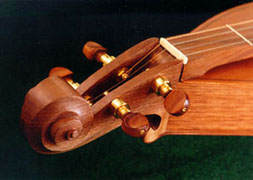Carving the Scroll Peghead
The Peghead is the beginning piece of each instrument. It is the maker's signature upon the instrument. You can discern a lot about the general character of the instrument, and its maker's approach to the work, by studying the details of the peghead. Here is where to look for the luthier's sense of design, balance, proportion and grace. If he or she shines here, you can be sure the work is serious in places you cannot see.
 The first step in carving the peghead is to cut the profile from the block. A block of walnut is selected which is accurately quarter sawn and of clear, straight grain. There must be no cracks, voids, or other malformaties in this piece of wood, for it will be handling large forces in the instrument.
The first step in carving the peghead is to cut the profile from the block. A block of walnut is selected which is accurately quarter sawn and of clear, straight grain. There must be no cracks, voids, or other malformaties in this piece of wood, for it will be handling large forces in the instrument.
 Now, having marked out cutting lines with pencil and gone over them with a knife to avoid chipping, we take up the 1/2" mortise chisel and cut in to begin carving out the peg alley. The peg alley is where the pegs or mechanical tuners are carried.
Now, having marked out cutting lines with pencil and gone over them with a knife to avoid chipping, we take up the 1/2" mortise chisel and cut in to begin carving out the peg alley. The peg alley is where the pegs or mechanical tuners are carried.
 Next, the waste is sawn away at the bandsaw. That is the last power tool operation on the peghead. Now we clamp the peghead in the bench vise again, and take up the gouge and mallet to begin rough carving.
Next, the waste is sawn away at the bandsaw. That is the last power tool operation on the peghead. Now we clamp the peghead in the bench vise again, and take up the gouge and mallet to begin rough carving.
 Defining the scroll comes next. Here we will rough out the spiral shape and its progressive heights. This scroll was original laid out by Walter Martin, and is a free-hand creation, using French curves.
Defining the scroll comes next. Here we will rough out the spiral shape and its progressive heights. This scroll was original laid out by Walter Martin, and is a free-hand creation, using French curves.
 Finally, we define the cove. The cove unifies the shank's little gestural scroll, the peg alley, and the scroll and creates a flow from the lines of the body's ribs into the dramatic finial of the peghead.
Finally, we define the cove. The cove unifies the shank's little gestural scroll, the peg alley, and the scroll and creates a flow from the lines of the body's ribs into the dramatic finial of the peghead.
We will leave the scroll in the carved state for now. After it has been incorporated into the dulcimer body, the cove and heel gestural scroll will be faired into the ribs and bottom of the instrument.

